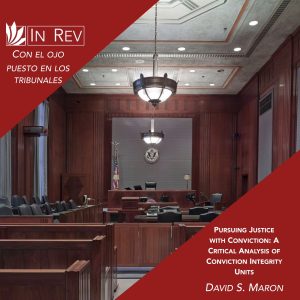
David S. Maron*
Introduction
While exonerations of wrongful convictions have deservedly become a prominent focus of the criminal justice discourse in recent years, they are not new to the United States justice system.[1] The first recorded exoneration took place in Vermont in 1819 when two brothers, Jesse and Stephen Boorn, were accused of murdering their brother-in-law, Russell Colvin.[2] The case bears many of the modern hallmarks of wrongful conviction cases, such as jailhouse informants who were incentivized by the state to cooperate through reduced sentences, junk science, and mistaken eyewitness identifications.[3] If the alleged murder victim had not been found alive and well in New York and pressured to return to Vermont, the brothers would have faced capital punishment.[4] In the 204 years since this first exoneration, the United States justice system has undergone many necessary reforms.[5] The current rate of wrongful convictions, however, leaves much to be desired.[6] For every eight people executed by the United States government, one person on death row is exonerated.[7] A margin of error of this magnitude when dealing with state-sanctioned death is not only morally reprehensible, but reflective of the institutional change that is necessary in the criminal justice system.
In addition to sentence appeals, there are some other remedies that the wrongfully convicted can pursue. Nevertheless, each comes with its own set of obstacles that make relief inaccessible to most. In the current court systems, the major remedies consist of habeas corpus, which determines whether a person’s detention is lawful,[8] and coram nobis, a plea to bring forward new facts or evidence.[9] Habeas claims must have a strict constitutional relevance to be successful,[10] and coram nobis pleas have excessively high standards for what constitutes “new evidence”,[11] making them both poor paths for the wrongfully convicted. Through the executive branch, the wrongfully convicted can pursue clemency. This path, however, has proven to be notoriously political.[12] The one relief that has shown some promise is DNA evidence testing, where every state has established its own set of rules for introducing and testing evidence.[13] While the opportunities look scarce for the wrongly convicted, there is one surprising new path that has shown extraordinary promise: the prosecutor’s office.
I. Conviction Integrity Units
Conviction Integrity Units (hereafter CIUs) are specialized units within the office of local prosecutors whose sole focus is to review the claims of the wrongly convicted.[14] The first CIU was established in Santa Ana, California in 2004, before being disbanded and then reassembled in 2008.[15]Dallas, Texas has the longest-standing CIU, with its founding in 2007.[16] It seems hardly a coincidence that just as CIUs were gaining traction and popularity, the American Bar Association took notice and “amended the Model Rules (MR) by adopting MR 3.8(g) and (h), which, for the first time, enumerated a prosecutor’s ethical duties in the face of evidence of a possible wrongful conviction.”[17] This made it clear to prosecutors across the United States that seeking justice, not convictions, would always be the main priority. MR 3.8(g) compels the prosecutor to disclose any new evidence that could undermine the conviction and conduct appropriate investigations and MR 3.8 (h) takes it a step further, compelling the prosecutor to remedy a conviction upon learning of convincing evidence that proves that said offense wasn’t committed.[18] In a system where high conviction rates lead to promotions, and prosecutors are lauded for ‘winning’ cases, MR 3.8 helps shift the focus of the ministers of justice back to their main mission, the pursuit of justice.
A. Structure of CIUs
CIUs function as decentralized units that exist within particular counties, as opposed to being part of a centralized, federal program.[19] Some states have begun to create state-wide CIUs. However, the state attorney general does not typically have jurisdiction to review a claim of innocence, so these CIUs mainly function as support to the county’s CIUs and provide them with much needed resources.[20] County specific CIUs are established by the sitting district attorney of that county.[21] Because of the decentralized nature of these units, their standards of review, creation, design, staffing, and internal procedures vary across counties.[22] Much of this variability stems from the vastly different resources available to each county’s disposal.[23]For instance, while some counties have a large number of assistant prosecutors and investigators dedicated solely to the CIU, others are chronically understaffed . Across all of the variability, there remain two constant requirements for CIUs: the case must have been prosecuted in the same jurisdiction where the CIU is located and the defendant must of course still be alive.[24]
i. Individual Intricacies of CIUs
When it comes to standards of review, CIUs span the spectrum of case selection, from highly selective to more flexible.[25] On one end of the spectrum, CIUs with narrow scopes accept only cases where the defendant claims actual innocence, and many of these jurisdictions rule out cases where the defendant pleaded guilty at trial.[26] This can be particularly problematic because it does not take into account the possibility that an innocent defendant might have been coerced into accepting a plea deal.[27]
Broad scope standards of review are more frequently seen in bigger counties with more prosecutors and resources dedicated exclusively to the CIU.[28] Many of these counties require a credible claim of innocence as a prerequisite for filing a petition.[29] However, there has been a recent trend towards reviewing cases based on wrongful conviction,[30] regardless of whether the defendant claims actual innocence or not. The CIU in Philadelphia County is a poignant example of this broad scope of review. In their official request for review form, they define a wrongful conviction as follows: “wrongfully convicted but not actually innocent means that, although you had some involvement in the crime, the evidence used against you at trial was tainted in some way … OR there was a constitutional violation of your fair right to trial[.]”[31] Philadelphia’s CIU, being one of the most progressive in the nation, also reviews other matters, such as claims of disproportionately long sentences.[32] This broad standard of review is often referred to as an “interest of justice” standard.[33] Under this standard, CIUs gain the flexibility to review cases without the constraint of having to find newly discovered evidence of innocence, bringing the focus back to the comprehensive integrity of the conviction.[34]
While the focus of all CIUs is the retroactive examination of potential wrongful convictions, an equally important objective is the proactive steps that prosecutors’ offices can take to prevent future wrongful convictions.[35] As stated by Kristine Hamman, founder of the Prosecutors’ Center for Excellence, in the report Conviction Review Today: A Guide for Prosecutors, “[a]culture of integrity should define a prosecutor office. It is axiomatic that the best way to prevent a wrongful conviction is to get it right the first time.”[36] Among these steps for proactive integrity, four stand out as best practices: first, familiarizing prosecutors with common errors that lead to wrongful convictions and best practices to follow when conducting investigations;[37] second, creating tangible checklists for prosecutors to follow as they are conducting investigations;[38] third, pre-trial exoneration reviews where prosecutors have the ability to rectify a charge prior to sentencing when evidence of innocence is found;[39] fourth, a root cause analysis exercise, wherein prosecutors convene after a wrongful conviction exoneration to determine where the prosecution went wrong and what steps can be taken in the future with similar cases.[40]
II. Necessary Partnerships:
CIUs are not alone in this fight for justice. Of the 233 exonerations recorded in 2022, CIUs worked hand in hand with innocence organizations on 121 of them.[41] This collaboration is particularly essential for CIUs in smaller offices with fewer allocated prosecutors and resources. Aid from innocence organizations can come in many forms, such as a source for conviction review requests[42] or as part of an external advisory panel assisting in the investigation.[43].When accepting cases for review, CIUs often look favorably on cases referred by innocence organizations, due to the fact that innocence organizations tend to conduct preliminary research that is extremely useful to CIUs when beginning their investigations.[44]Innocence organizations are known to only pass on credible claims of innocence, thus acting as a filter to allow the CIUs to use their time in the most effective way possible.[45] Some CIUs, such as the one operating in New York County, NY allow an external advisory board to have influence over their general policy, but not over specific cases.[46] Others, such as the CIU in Kings County, NY, have an independent external advisory panel that makes its own recommendations, which are passed on to the District Attorney, along with the CIUs recommendations.[47]
III. CIUs: Added Perspectives and Potential Problems
There is one glaring critique of CIUs that must be discussed, and that is what is often referred to as “CIUs in name only”. These are CIUs that have been established by district attorneys seeking to improve their public relations optics, but, in reality, these CIUs are nothing more than a facade to improve public opinion.[48] As elected officials, district attorneys have an immense incentive to stay in the good favor of the public, and for many this means appearing progressive. Establishing a CIU in their county can make district attorneys look more accountable and responsible, willing to rectify any mistakes that their offices might have made. Although in many counties this may enhance the search for justice, it can be argued that not all districts use this tool for the right reasons. The problem becomes apparent when viewing some statistics on CIUs. There are 52 CIUs in the United States with at least one exoneration, and there are 49 CIUs in the United States without a single exoneration.[49] Does this mean that almost half of the CIUs in the United States are CIUs in name only? Probably not. Lack of funding and resources is a likely contributor to many of these CIUs’ underwhelming performance, a harsh obstacle for well-intentioned prosecutors.[50] However, some of these CIUs are more than likely “in name only”, created as a shining star that district attorneys can add to their resumes without actually doing any of the necessary work. In either scenario, implementation of and reliance on an external advisory panel would add a much-needed funnel for resources as well as an added layer of accountability.
A. CIUs Best Examples and Two Cautionary Tales
When looking at how many recorded exonerations each CIU has, there are two major outliers. Cook County, Illinois has a staggering 230 exonerations,[51] and Harris County in Texas has 175.[52] The CIU that follows these numbers is Kings County in New York with 70 exonerations to date.[53] This is not to devalue the efficacy of Kings County, as it is arguably one of the most well managed and highest functioning units in the country. Yet, it begs the question: what is going on in Cook County and Harris County? To answer that question, we need to revisit two troubling scandals that occurred in these counties.
It is worth noting that Cook County encompasses Chicago and Harris County encompasses Houston, making these some of the largest counties in the United States by population, and thus these CIUs have access to more resources than smaller counties do. In both Cook and Harris County, the two top counties for exonerations in the United States, the CIUs conducted systemic reviews of large-scale scandals that affected hundreds of people and led to hundreds of wrongful convictions.[54] In Harris County, Texas, while conducting confirmatory tests on backlogged drug testing cases, prosecutors uncovered an error in the lab results.[55] This led to the discovery that more than 119 people had pled guilty and been convicted of controlled substance violations even though the substances involved were not in fact controlled substances.[56] The CIU in Harris County undertook the mission to bring justice to the wrongly accused.
The history of Cook County, Illinois tells a more nefarious tale. The Sergeant Watts scandal in Cook County was the culmination of over ten years of deliberate police misconduct.[57] Per federal prosecutors, Watts was “stealing drug money and extorting protections from the drug dealers who terrorized the community that he (Watts) had sworn to protect.”[58] Over the course of many years, the Cook County CIU, in conjunction with the Exoneration Project, has uncovered many false convictions based on drug evidence planted by the police.[59] Far over 200 convictions have been thrown out.[60] These examples of systemic exonerations prove how useful a CIU can be in detecting miscarriages of justice and bringing relief to the wrongfully accused. This is true whether it be for cases involving mere mistakes, or deliberate actions by agents of the public order.
Conclusion
CIUs have come a long way since the first one was founded in 2004,[61] and they have a promising future in promulgating post-conviction justice. The close to twenty-year history of these units means that through critical analysis, some better practices can be established. One factor of importance that almost all CIUs follow is removing the original prosecutor from the CIU investigation to minimize bias.[62] Another factor that contributes to CIU success is the involvement of an external advisory board that can add accountability, a fresh perspective, and much-needed resources to the CIUs.[63] Innocence organizations have proven their efficacy in working alongside CIUs, with over half of 2022’s recorded exonerations coming as a product of collaboration between the two. Progressive CIUs like those in Philadelphia County, PA, and Kings County, NY, are expanding the aperture of cases eligible for review, bringing a more comprehensive approach to the post-conviction process. As more counties develop CIUs, and as these CIUs broaden their standards of review, the future of post-conviction relief and exonerations of innocent individuals has never looked brighter.
* The author is a research assistant at the University of Puerto Rico School of Law’s Proyecto ADN Post Sentencia. He graduated from Washington University in St. Louis with a Bachelor’s degree in Political Science and Psychology in 2021.
[1] See Seri Irazola et al., Study of Victim Experiences of Wrongful Conviction, DOJ (November 2013), https://www.ojp.gov/pdffiles1/nij/grants/244084.pdf.
[2] Bluhm Legal Clinic, Center on Wrongful Convictions: First wrongful conviction, NORTHWESTERN PRITZKER SCHOOL OF LAW, https://www.law.northwestern.edu/legalclinic/wrongfulconvictions/exonerations/vt/boorn-brothers.html, (last visited March 5, 2024).
[3] Id.
[4] Id.
[5] See Pamela K. Lattimore, Reflections on Criminal Justice Reform: Challenges and Opportunities,47 AM. J. CRIM. JUST. 1071 (2022).
[6] Kiara Alfonseca, The fight for exoneration: Over 29,100 years ‘lost’ in prison in wrongful convictions, database finds, ABC NEWS (March 17, 2023), https://abcnews.go.com/US/fight-exoneration-29100-years-lost-prison-wrongful-convictions/story?id=97907275;
[7] EQUAL JUSTICE INITIATIVE, Death penalty, https://eji.org/issues/death-penalty/ (last visited March 5, 2024).
[8] ACLU, What You Should Know Aout Habeas Corpus (April 20, 2007), https://www.aclu.org/documents/what-you-should-know-about-habeas-corpus#:~:text=The%20“Great%20Writ”%20of%20habeas,freedom%20against%20arbitrary%20executive%20power.
[9] David Wolitz, The Stigma of Conviction: Coram Nobis, Civil Disabilities, and the Right to Clear One’s Name, GEO. U. L. CTR., 2009, at 6, https://scholarship.law.georgetown.edu/cgi/viewcontent.cgi?article=1113&context=fwps_papers.
[10] DANIEL S. MEDWED, BARRED: WHY THE INNOCENT CAN’T GET OUT OF PRISON 76-77 (2022).
[11] Id. at 91.
[12] Id. at 140-41; Anne McMillan, The pardon: politics or mercy?, INTERNATIONAL BAR ASSOCIATION, https://www.ibanet.org/article/465431E6-8846-4A89-BA0A-6A8B85E5ED1D (last visited March 18, 2024).
[13] NATIONAL INSTITUTE OF JUSTICE, Principles of Forensic DNA for Officers of the Court, https://nij.ojp.gov/nij-hosted-online-training-courses/principles-forensic-dna-officers-court/09-forensic-dna-databases/using-dna-databases-investigate-crimes/state-statutes-and-dna-databasing-cont#state-statutes-and-dna-databasing-cont (last visited March 17, 2024).
[14] INNOCENCE PROJECT, Conviction Integrity Unit Best Practices, (October 15, 2015), https://www.innocenceproject.org/wp-content/uploads/2016/09/Conviction-Integrity-Unit.pdf.
[15] JOHN HOLLWAY, CONVICTION REVIEW UNITS: A NATIONAL PERSPECTIVE 10 (Faculty Scholarship at Penn Carey Law, (2016), https://scholarship.law.upenn.edu/cgi/viewcontent.cgi?article=2615&context=faculty_scholarship.
[16] Id.
[17] Lissa Griffin & Daisy Mason, The Prosecutor in the Mirror: Conviction Integrity Units and Brady claims, 55 LOY. L.A.L. REV. 1005, 1011 (2022).
[18] MODEL RULES OF PROF’L CONDUCT r. 3.8 (2008).
[19] Conviction Integrity Unit Best Practices, supra note 14; KRISTINE HAMANN ET AL., CONVICTION REVIEW TODAY: A GUIDE FOR, PROSECUTORS 4 (CENTER FOR EXCELLENCE, October 2020), https://pceinc.org/wp-content/uploads/2020/12/20201209-Conviction-Review-Final.pdf.
[20] HAMANN, supra note 19 at 14-15.
[21] Conviction Integrity Unit Best Practices, supra note 13, at 1.
[22] Id.; HOLLWAY, supra note 15.
[23] Griffin & Mason, supra note 17, at 1015-16.
[24] Mallory Emma Garvin, In the Interest of Justice: The Gold Standard for Conviction Integrity Units, SETON HALL L. (2023), at 13-14, https://scholarship.shu.edu/cgi/viewcontent.cgi?article=2313&context=student_scholarship#:~:text=When%20a%20CIU%20determines%20that,reviewing%20cases%20to%20ensure%20that.
[25] Id. at 14.
[26] Id.
[27] HOLLWAY, supra note 15, at 43.
[28] HOLLWAY, supra note 15, at 37.
[29] Id. at 39.
[30] Garvin, supra note 25, at 14.
[31] CONVICTION INTEGRITY UNIT (CIU) SUBMISSION FORM/REQUEST FOR REVIEW (October 4, 2021), https://phillyda.org/wp-content/uploads/2022/01/CIU-Pro-Se-Submission-Form-Final-Revised-10-04-2021.pdf.
[32] Id.; Cody McGraw, Prosecuting With Compassion, Defending With Power: Progressive Prosecutors And The Case For Rehabilitative Justice, 9 PENN. ST. J.L. & INT’L AFF. 261, 265 (2021); Emily Haavik, Philadelphia leads the charge in exonerating its own convicted prisoners, KARE11 (June 22, 2021), https://www.kare11.com/article/syndication/podcasts/record-of-wrong/philadelphia-conviction-integrity-unit-larry-krasner-patricia-cummings/89-fe603fb4-7532-4093-8245-1ef09b7938a7.
[33] Garvin, supra note 25, at 14.
[34] Barry C. Scheck, Conviction Integrity Units Revisited, 14 OHIO ST. J. CRIM. L. 705, 728 (2017).
[35] HAMANN ET AL., supra note 19, at 55.
[36] Id. at 61.
[37] Id.at 8.
[38] Id.
[39] Id.
[40] Id.
[41] The National Registry of Exonerations, 2022 Annual Report, UNIVERSITY OF MICHIGAN LAW SCHOOL, (May 8, 2023), at 4, https://www.law.umich.edu/special/exoneration/Documents/NRE%20Annual%20Report%202022.pdf.
[42] Garvin, supra note 25, at 13.
[43] HAMANN ET AL., supra note 19, at 26.
[44] Id. at 29.
[45] HOLLWAY, supra note 15, at 40.
[46] Scheck, supra note 36, at 740.
[47] Id. at 30.
[48] Id. at 19.
[49] The National Registry of Exonerations, Conviction Integrity Units, https://www.law.umich.edu/special/exoneration/Pages/about.aspx (November 7, 2023).
[50] See HOLLWAY, supra note 15, at 21, 32.
[51] The National Registry of Exonerations, Top Ten Counties, UNIVERSITY OF MICHIGAN LAW SCHOOL, https://www.law.umich.edu/special/exoneration/Pages/Top-Ten-Counties.aspx, (last visited March 17, 2024) (The statistics found in this source are from 2019 and have possibly changed since then).
[52] Id.
[53] Id.
[54] Garvin, supra note 25, at 9-10.
[55] Scheck, supra note 36, at 726.
[56] Id.
[57] The National Registry of Exonerations, Exonerations in 2018, UNIVERSITY OF MICHIGAN LAW SCHOOL (April 9, 2019), at 9, https://www.law.umich.edu/special/exoneration/Documents/Exonerations%20in%202018.pdf.
[58] Id. at 10.
[59] Illinois 2016 (1), THE NATIONAL REGISTRY OF EXONERATIONS, https://exonerations.newkirkcenter.uci.edu/groups/group-exonerations/illinois-2016-1 (last visited April 25, 2024).
[60] Kevin Jay Long, Watts Team Scandal, THE EXONERATION PROJECT (October 22, 2022), https://www.exonerationproject.org/stories/watts-team-scandal/#:~:text=Disgraced%20former%20Chicago%20Police%20Sergeant,mass%20exoneration%20in%20Chicago%20history.
[61] HOLLWAY, supra note 15.
[62] INNOCENCE PROJECT, supra note 14; HOLLWAY, supra note 15, at 2.
[63] Id. at 28.




